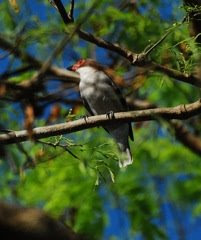
The Tityra sounds like a Shakespeare character, but it’s really a fly catching bird of the tropical type found in exotic Mexico and Central American countries. Many sub varietal differentiated species of the Tityra exist, usually denoted by exotic color trim on the basic plumage design. The “flycatcher” bird will occur in Tropical Belize, Honduras, Paraguay, Mexico, Costa Rica, Peru, and Amazonian areas as well as other countries in that area.
The arboreal habitat preferred by the Tityra defines its diet. Fly catching, insect eating, fruit munching, and casual lizard snacking makes the Tityra protein diet a varied one. The natural habitats of the Tityra are subtropical or tropical forests, and variable forest wildlands affording cover and perch hunting. The Tityra’s bark is worse than its bite, a harsh grunting, beak infused froggy squawk or hooting call. The long bill, angled neck in profile and watchful and alert behavior, and the squat puffiness give the Tityra an aloof air.
Tityra birds are smallish, eight inch tropical birds with vivid stripes, wing chevrons, masks, and other colorations. Tityras have delicate forelegs, alert neck stances, sharpish beaks, plump little torsos and compact underparts. The alert eyes are highlighted by dramatic “masks” and striped accents contrasting with mostly gray or buff neutral coloring. Variable Tityra plumage is a wonder to behold, delicate shadings in the wings and shoulders fading to camouflage with tree
habitats।
Tityras may perch in pairs and indulge their frugivore and insectivore lifestyles with a spot of lizard invertebrate. These species are found in forest clearings and edges, second scrub growth and other semi-open habitats such as plantation shade trees. Black Tailed Tityras and Black Crowned Tityras also forage with tree cover blending into their feather combinations. Female Tityras will have more brown feathers and combinations, possibly due to blend more subtly with natural forest cover.
The sporty Tityra relaxes into mating activities like other tropical birds। The Tityras brood and nest in a clutch of eggs seasonally। The eggs are laid in a bed of dry leaves in a tree hole or adopted nest from another bird like a woodpecker, toucan, or other arboreal borer। The Tityra female incubates alone, but co-parenting occurs.
The arboreal habitat preferred by the Tityra defines its diet. Fly catching, insect eating, fruit munching, and casual lizard snacking makes the Tityra protein diet a varied one. The natural habitats of the Tityra are subtropical or tropical forests, and variable forest wildlands affording cover and perch hunting. The Tityra’s bark is worse than its bite, a harsh grunting, beak infused froggy squawk or hooting call. The long bill, angled neck in profile and watchful and alert behavior, and the squat puffiness give the Tityra an aloof air.
Tityra birds are smallish, eight inch tropical birds with vivid stripes, wing chevrons, masks, and other colorations. Tityras have delicate forelegs, alert neck stances, sharpish beaks, plump little torsos and compact underparts. The alert eyes are highlighted by dramatic “masks” and striped accents contrasting with mostly gray or buff neutral coloring. Variable Tityra plumage is a wonder to behold, delicate shadings in the wings and shoulders fading to camouflage with tree
habitats।
Tityras may perch in pairs and indulge their frugivore and insectivore lifestyles with a spot of lizard invertebrate. These species are found in forest clearings and edges, second scrub growth and other semi-open habitats such as plantation shade trees. Black Tailed Tityras and Black Crowned Tityras also forage with tree cover blending into their feather combinations. Female Tityras will have more brown feathers and combinations, possibly due to blend more subtly with natural forest cover.
The sporty Tityra relaxes into mating activities like other tropical birds। The Tityras brood and nest in a clutch of eggs seasonally। The eggs are laid in a bed of dry leaves in a tree hole or adopted nest from another bird like a woodpecker, toucan, or other arboreal borer। The Tityra female incubates alone, but co-parenting occurs.
Bird NEWS
Exsotic Birds Dashboard
Protect the World's Forests
Bird Gallery
Rainforest Facts
Global Warming
Tropical bird species evolved without isolation
Rain Forest Picturs

